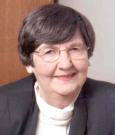Title: Lighter as We Go: Virtues, Character Strengths, and Aging
Authors: Mindy Greenstein, PhD, and Jimmie Holland, MD
Publisher: Oxford University Press
Publication date: September 2014
Price: $27.95; Hardcover, 320 pages
Death is the universal experience shared by Earth’s 7 billion or so inhabitants, from street beggars in Mumbai to Wall Street investment bankers. Another common human experience is our determination to forestall death. However, while humans strive to live as long as possible, there’s also a common dread of losing youthful vigor as life’s journey moves into its later years—the human paradox of wanting to live forever but not grow old.
Aside from X’s on a calendar, wrinkled skin, and forgetfulness, what is aging and why do we fear it? This big philosophical question has been tackled in a captivating new book, Lighter as We Go: Virtues, Character Strengths, and Aging, by Mindy Greenstein, PhD, and Jimmie Holland, MD, both of Memorial Sloan Kettering Cancer Center in New York.
About the Authors
In 1977, Dr. Holland took a position at Memorial Sloan Kettering, where she developed the first psychological and psychiatric services center in a cancer center. Her groundbreaking work would mature into the subspecialty of psycho-oncology practice.
Since cancer is largely a disease of aging, Dr. Holland’s life’s work informed the writing of this intriguing book. Similarly, her coauthor and Memorial Sloan Kettering colleague, Dr. Greenstein, is a clinical psychologist with extensive experience talking with emotionally vulnerable cancer patients facing an uncertain future.
Dr. Holland turned 85 during the writing of this book. Dr. Greenstein is 50, and in the introduction, the readers learn that she is a breast cancer survivor, having been diagnosed at the age of 49.
Book collaboration is difficult and can strain the best of colleagues, but the authors’ voices are seamlessly woven throughout the narrative, and even before finishing the introduction, you will come to like these smart and compassionate women. They bring erudition and hard-earned experiential knowledge to the pages of their book.
Character-Building Experiences
Lighter as We Go is about social science and the results of research that shed light on the way people experience life as they move from youth to old age and how, if we pay attention, we can integrate the character-building lessons of aging into other parts of our society—and into cancer care, too. Also, in the words of the authors, “From our different vantage points, we can both see how much society needs an attitude adjustment when it comes to aging.”
Divided into three sections and 13 chapters, Lighter as We Go asks difficult questions and then explores the answers using anecdotal and research-backed narratives. For instance, in chapter 1, “The Oak Tree and The U-Bend,” the authors ask, “So, what is this me?” This me can be defined and realized by the term character, which has fallen into disuse in the contemporary psychiatric community. But Drs. Holland and Greenstein argue that character is an essential component of the healthy aging process, especially in a youth-oriented society that enforces negative stereotypes that “scare the young and make elders feel worse about themselves. Mid-lifers fear becoming old, and young adults fear becoming mid-lifers, like one long cascading domino effect of the fear of aging.”
For help on this issue, they refer to psychologist James Hillman, who noted that it takes a lot of living to develop character, and it only emerges in elders. “How we age, the patterns we regularly perform, and the style of our image show the character at work. As character directs aging, aging reveals character.”
Identity Balance
The authors’ use of stimulating analogy is shown early in the book when citing research by Joel Sneed and Susan Whitbourne, psychologists who developed what is called “identity balance theory,” which suggests that there are processes that help us keep a balanced sense of who we are, even as we age and change in appearance. They explain that the idea of identity balance comes from the fact that not every new experience leads to changing fundamental qualities or how you define yourself. And even when major changes in one’s life occur, there is still a core identity underpinning those changes.
Professional athletes, whose personal identity is forged to their sport, experience a radical change of life because their careers are cut so short by age. The authors use legendary Cleveland Indians pitcher Bob Feller as an example of how character withstands upheaval and enhances the aging process. After retiring as one of history’s most notable pitchers, Feller built a successful insurance company and became a licensed pilot, living a long and fulfilling life. “While some core aspects of his identity changed over the years, other core aspects stayed the same, and he could experience himself as a coherent whole, despite the dramatic changes,” the authors write.
‘U-Bend’ Phenomenon
In an absorbing discussion, Drs. Holland and Greenstein look at a phenomenon that consistently finds its way into the social science literature called the “U-Bend” of life. According to the authors, research has surprisingly shown that the age group that feels the greatest sense of well-being is the 82- to 85-year-old group. Eighteen year olds have a very high sense of enjoyment of life, but those feelings begin sliding, reaching bottom around the early 50s. After that, feelings of well-being bend upward rather rapidly, peaking in the early 80s—hence, the U-Bend phenomenon, which is not completely understood.
“So, what might be going on, and what can we learn from it?” the authors ask. To that end, they discuss a 2009 Yale study that found people who have negative stereotypes of aging when they are young are more likely to have serious chronic illnesses as they get older, compared with those with a more positive view of aging. One possible explanation (that’s examined in chapter 9) is that people with more positive expectations about old age might be more likely to develop healthier lifestyles. Therefore, teaching the young to embrace aspects of their own aging could lead to better health outcomes for future generations of elderly.
Mixing social science with anecdotal forays into the personal experiences of real people can be tricky, and if done with too heavy a hand, downright deadly to a serious book such as this. But Drs. Holland and Greenstein are natural storytellers, and they put human faces on each topic they engage.
For example, Nancy Miller, a 63-year-retired engineer says, “People over 60 have less to lose. Their striving is over, and now you can take risks. It’s time to be generative. You have to go out of your way to connect with people.” That’s a powerful sentiment, shared by millions of Americans.
The authors seize on the complicated notion of being generative. Citing the psychologist Erik Erikson, who in 1950 theorized that mid-life was the time in our life to generate and nurture the next generation. And quite poetically, psychiatrist George Vaillant “refers to us [mid-lifers] as society’s ‘keepers of meaning,’ a role we will continue into older age.”
Important Lesson
Along with deep and thoughtful explorations of aging that will assuredly enlighten their audience, the authors give even more, such as chapter 4, “Older Age in the Olden Days: A History of Aging in the Western World.” This chapter details the history of our very complicated relationship with age and mortality, from antiquity to present day. The authors sum up this edifying section thusly: “Perhaps one of the most important lessons of history is the importance of learning to reconcile the good with the bad, the things we can control with the things we can’t, the older with the younger.”
Lighter as We Go does not glorify old age. But by explaining the multilayered physical and psychological processes of aging, the book defends the old against crass ageists that populate much of our pop culture. More important, without being the least bit didactic, Drs. Holland and Greenstein have open-mindedly explored and discussed a societal topic that still remains sorely misunderstood, partly out of our universal fear of aging. This bold and liberating book should be on everyone’s reading list, regardless of age. ■



